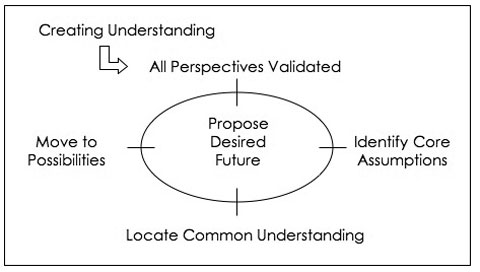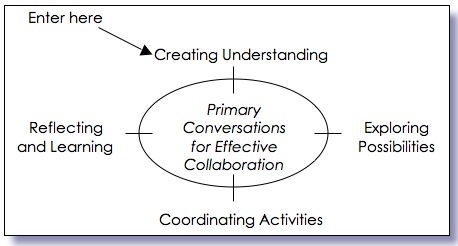Recap: My assertion is that in order to create a future where we thrive we must create conversations where we collaborate.
My last post contained the following model that serves as a “meta-map” for creating collaborative conversations:
This model grew out of many years of observing that there appear to be four types of conversations that support people in successfully creating mutually desired futures.
Developing knowledge and skill in these conversations is a powerful leverage point for leaders whose job involves getting people to work together towards a future they want to create.
Once a desired future has been identified as worth working toward, the next step in the Leading Collaborative Conversations (LCC) model is creating understanding.
Understanding is a marvelous thing. Metaphorically speaking, it can restore eyesight to the blind. It can sooth hurt feelings, assuage guilt, calm anger, activate deep compassion, and release enormous amounts of creativity and passion.
Understanding among and between people flows from the creation of shared meaning.
Shared meaning does not mean that everyone in the conversation sees things in the same way.
Shared meaning does mean each stakeholder in the conversation shares what is meaningful to them as it pertains to creating the desired future those in the conversation are seeking to create.
Shared meaning occurs when people understand each other’s perspectives well enough to accept them as legitimate in the context of exploring and realizing a desired future.
When attempting to bring people together to create a mutually desired future, it is extremely important that core assumptions are explored to make sure that everyone has shared meaning before proceeding.
Core assumptions are usually linked to common words. Right now “leadership” and “change” are two words being bandied about a fair bit these days. Ask a friend or associate what they understand either of these words to mean and see how their definition jibes with your own. How much meaning do you share? How much diversity of opinion do you have? If you are working together and your success depends on the shared meaning your have of these words, how successful will you be?
Also critical, is ensuring that any past injuries needing redress are aired before going into the later stages of the model. Failure to do so could lead to major breakdowns later on. If necessary, third party intervention might be called for.
Depending on the relationships of stakeholders involved, creating shared meaning may be accomplished quickly or it might take many sessions.

Shared meaning lays a foundation that will support the fruitful exploration of possibilities.
Let’s apply this to a real life situation.
I was recently in Louisville, Kentucky leading a day-long dialogue with about 100 ordained faith leaders. We had many Ministers and Priests, a few Imans and Rabbis, a Tibetan Buddhist monk, leaders for the B’hai faith, some Zen practitioners, a few Quakers and some others folks.
The Center for Interfaith Relations convened this dialogue. Their “desired future” is a vibrant community of actively involved interfaith leaders who work together in creating a better future for Louisville. CIR convened this dialogue with an invitation to faith leaders to come to explore what it means not only to be a faith leader, but an interfaith leader.
Each of the participants arrived with an identity and an understanding of what it means to be a leader in their faith tradition, as well as a personal point of view on what it means to be an interfaith leader.
However, at the beginning of the day among the hundred gathered, there was not much shared meaning around being an interfaith leader.
It is highly doubtful that it would it have been fruitful to go the Webster’s dictionary and transcribe its definition onto a powerpoint slide and use that as a basis for moving these people forward.
Instead we created a conversational structure that allowed each and every person in that room to weigh in on what it meant to be an interfaith leader and to hear a multitude of perspectives from other traditions that could inform them in deciding if such leadership was worthwhile or not.
It took several hours to establish a shared sense of what interfaith leadership is and why it is a worthwhile pursuit. Only then were we ready to move on to exploring possibilities for making Louisville’s future better and the role that interfaith leaders will play in that effort.
Reflection questions:
What is clearer to you after reading this post?
What are some examples where you know you have skill in creating understanding and shared meaning?
What, if anything, is challenging to you in this post?

Leave a comment